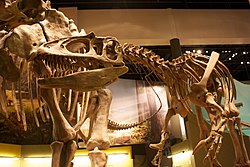Saurophaganax maximus
|
Saurophaganax Temporal range: Late Jurassic, 150 Ma |
|
|---|---|
 |
|
| Reconstructed skeleton, Sam Noble Oklahoma Museum of Natural History | |
| Scientific classification | |
| Kingdom: | Animalia |
| Phylum: | Chordata |
| Class: | Reptilia |
| Clade: | Dinosauria |
| Order: | Saurischia |
| Suborder: | Theropoda |
| Family: | †Allosauridae |
| Genus: |
†Saurophaganax Chure, 1995 |
| Species: | †S. maximus |
| Binomial name | |
|
Saurophaganax maximus Chure, 1995 |
|
| Synonyms | |
|
"Saurophagus maximus" Stovall, 1941 (preoccupied) |
|
"Saurophagus maximus" Stovall, 1941 (preoccupied)
Allosaurus maximus (Chure, 1995)
Saurophaganax ("lizard-eater") is a genus of allosaurid dinosaur from the Morrison Formation of Late Jurassic Oklahoma (latest Kimmeridgian age, about 151 million years ago), USA. Some paleontologists consider it to be a species of Allosaurus (A. maximus). Saurophaganax represents a very large Morrison allosaurid characterized by horizontal laminae at the bases of the dorsal neural spines above the transverse processes, and "meat-chopper" chevrons. The maximum size of S. maximus has been estimated at anywhere from 10.5 metres (34 ft) to 13 m (43 ft) in length, and around 3 tonnes (3.0 long tons; 3.3 short tons) in weight.
In 1931 and 1932 John Willis Stovall uncovered remains of a large theropod near Kenton in Cimarron County, Oklahoma in layers of the late Kimmeridgian. In 1941 these were named Saurophagus maximus by Stovall in an article by journalist Grace Ernestine Ray. The generic name is derived from Greek σαυρος, sauros, "lizard" and φάγειν, phagein, "to eat", with the compound meaning of "eater of saurians". The specific epithet maximus means "the largest" in Latin. Because the naming article did not contain a description, the name remained a nomen nudum. In 1987 Spencer George Lucas erroneously made OMNH 4666, a tibia, the lectotype, unaware that "Saurophagus" was a nomen nudum.
...
Wikipedia
